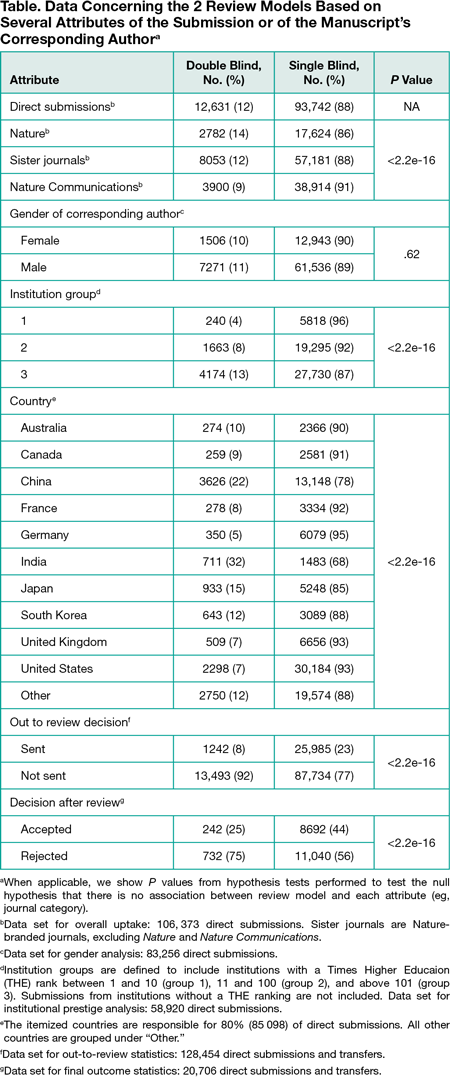Abstract
Analysis of Uptake and Outcome in Author-Selected Single-blind vs Double-blind Peer Review at Nature Journals
Elisa De Ranieri1; Barbara McGillivray2; Sowmya Swaminathan3; Michelle Samarasinghe4; Leah Gruen4
Objective
Double-blind peer review might avoid referee bias. The aims of this study were to analyze the demographics of corresponding authors choosing double-blind peer review and to identify differences in editorial outcome depending on review model.
Design
Data include direct submissions and transfers received between March 2015 and February 2017 by 25 Nature-branded journals. The authors chose either single- or double-blind review, and the editors were aware of the choice before taking any decisions. We analyzed direct submissions to study the uptake of double-blind review in relation to gender, country, and institutional prestige of the corresponding author. We analyzed all submissions to study the editorial outcome in relation to review model. The gender (male, female, or not available) of the corresponding authors was determined from their first name using a third-party service (Gender API), discarding results with less than 80% confidence. The prestige of corresponding author’s institutions was measured by normalizing the institution’s name using the Global Research Identifier Database (GRID) and dividing institutions in 3 prestige groups using the 2016 Times Higher Education (THE) ranking. We used descriptive statistics for data exploration; we tested our hypotheses using Pearson”s Χ² and binomial tests.
Results
Out of 128,454 papers, 106,373 were direct submissions, of which 12% were submitted double-blind review (Table). We found a small but significant association between journal tier and review type. We had gender information for 50,533 corresponding authors (in 83,256 submissions) and found no statistically significant difference in the distribution of peer-review model between males and females. We had 58,920 records with normalized institutions and a THE rank, and we found that corresponding authors from the less prestigious institutions are more likely to choose double-blind review. In the 10 countries with the highest number of submissions, we found a small but significant association between country and review type. China and the United States had a preference for double- and single-blind review, respectively. The outcome at both first decision and postreview was significantly more negative (ie, a higher likelihood for rejection) for double-blind than single-blind reviewed papers, and we attribute this to differences in the quality of the studies.
Conclusions
Authors choose double-blind review more frequently when they submit to more prestigious journals, when they are affiliated with less prestigious institutions, or when they are from specific countries. The double-blind option is also linked to less successful editorial outcomes.
1Springer Nature, London, UK, e.deranieri@nature.com; 2Alan Turing Institute and Department of Theoretical and Applied Linguistics, Faculty of Modern and Medieval Languages, University of Cambridge, UK; 3Springer Nature, San Francisco, CA, USA; 4Springer Nature, New York, NY, USA
Conflict of Interest Disclosures:
All authors are or have been employed by Springer Nature, which owns and publishes the Nature-branded journals.

